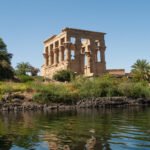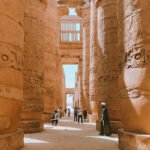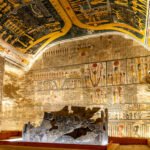Ancient Egyptian clothing holds great significance in understanding the culture, traditions, and social dynamics of Egypt. From the garments worn by pharaohs to the humble attire of slaves, clothing in ancient Egypt was not just about covering the body; it was a symbol of status, religion, and wealth.
Travelers interested in experiencing the majesty of Egypt’s past should dive into the fascinating world of ancient Egyptian clothes, where each piece tells a story of its wearer and the civilization they lived in.
Egyptian Clothing: The Basics
The warm climate of Egypt heavily influenced the clothing choices of ancient Egyptians. Made predominantly from linen, Egyptian clothing was designed to be lightweight and breathable.
Linen, derived from the flax plant, was favored for its cooling properties, which helped the wearer cope with the heat of Egypt’s desert landscape.
Both men and women, regardless of their social standing, commonly wore linen garments, with variations in style, length, and ornamentation reflecting their societal rank. For travelers exploring Egypt’s ancient history, examining these garments is like stepping into the shoes of the people who once roamed the sands of this majestic land.
Ancient Egyptian Men’s Clothing
Ancient Egyptian men’s clothing was relatively simple but elegant, with variations depending on the individual’s rank.
Most commoners wore a loincloth called a “shendyt,” a kilt-like garment that was tied at the waist and extended down to the knees or ankles. However, the social elite and pharaohs adorned themselves with more elaborate versions of this garment, sometimes crafted from finer linen or even embroidered with intricate designs and adorned with precious stones.
The male ancient Egyptian clothing reflects not only the practicalities of living in a hot climate but also the immense importance placed on showing one’s status through attire.
Ancient Egyptian Women’s Clothing
Ancient Egyptian women’s clothing was often more elaborate than their male counterparts. Women typically wore tight-fitting linen dresses called “kalasiris,” which varied in length from below the knee to the ankle.
Ancient Egyptian women’s clothing ranged from simple designs for commoners to more intricate styles for the wealthy and royalty. Some dresses had wide straps over the shoulders, while others were sleeveless or even strapless.
Elite women often accessorized with jewelry and ornamental belts to showcase their high status. If you’re exploring Egypt’s historical sites, picture how royal women such as Nefertiti or Cleopatra might have been draped in luxurious, flowing fabrics and exquisite jewelry.
Clothing for Royalty: Pharaohs and Queens
Ancient Egyptian clothing for pharaohs was distinct, emphasizing their divine status. Pharaohs, seen as gods on earth, wore elaborate garments that symbolized their power. Royal ancient Egyptian clothing for pharaohs often included pleated kilts, elaborate headdresses, and the famed royal nemes, a striped head cloth that signified their rule.
The pharaohs’ attire was also adorned with precious metals, such as gold, and featured intricate beadwork. Similarly, ancient Egyptian queen clothing was a reflection of their high rank and divinity. Queens and female royalty wore exquisite garments, often decorated with gold thread and gemstones.
For travelers visiting Egypt, seeing depictions of royal clothing in temple carvings and tomb paintings can provide a vivid glimpse into the opulence of the ancient Egyptian court.
Ancient Egyptian Slave Clothing
In stark contrast to the rich and intricate attire of the elite, ancient Egyptian clothing for slaves was simple and functional. Slaves, who made up a significant portion of the population, wore minimal clothing, often nothing more than a basic loincloth or a simple linen skirt.
Poor ancient Egyptian clothing lacked the ornamentation and luxurious fabrics seen in the attire of wealthier citizens. This simplicity reflected the limited resources available to them and their low status in society.
Despite their humble attire, slaves played a vital role in the building of Egypt’s monuments, such as the pyramids and temples. Travelers should appreciate the stark differences in clothing as they explore these ancient structures, understanding the societal divide reflected in the garments of the time.
Gender and Clothing in Ancient Egypt
The clothing of ancient Egyptians not only indicated social status but also reflected gender roles within society.
Female ancient Egyptian clothing was often designed to enhance the body’s natural shape, symbolizing fertility and femininity.
On the other hand, male ancient Egyptian clothing was more utilitarian, often designed to allow freedom of movement for labor or warfare. Interestingly, both genders used cosmetics and jewelry, highlighting how adornment was a vital part of expressing identity in ancient Egypt.
For tourists, understanding these dynamics adds depth to the experience of exploring ancient temples and tombs, where clothing played a significant role in art and religious practices.
Religious Significance of Ancient Egyptian Clothing
Clothing in ancient Egypt was also imbued with religious meaning. Certain garments were worn during religious ceremonies or to honor specific gods and goddesses.
Ancient Egyptian goddess clothing, for example, was depicted in murals showing goddesses like Isis and Hathor wearing elegant, flowing robes adorned with symbols of power and protection. Priests and priestesses had their own specialized garments, which were often made of pure white linen, symbolizing their purity and connection to the divine.
Travelers visiting religious sites like the Karnak Temple or the Valley of the Kings can appreciate how ancient Egyptian clothing was closely tied to spiritual beliefs, with every garment telling a story of faith and devotion.
Real Ancient Egyptian Clothing: Archaeological Discoveries
Archaeological discoveries have provided a wealth of knowledge about real ancient Egyptian clothing. Tomb paintings, statues, and even well-preserved textiles have revealed the intricacies of clothing design, from everyday wear to elaborate ceremonial garments.
In museums across Egypt, you can find actual pieces of ancient Egyptian clothing, allowing visitors a firsthand look at the craftsmanship that went into these garments. For travelers, visiting these museums and seeing ancient Egyptian clothing images or physically preserved garments offers a tangible connection to the past.
Clothing for the Afterlife: Funerary Garments
The ancient Egyptians believed that proper attire was just as essential in the afterlife as it was in life. Funerary clothing was often made of fine linen and included garments similar to those worn in everyday life but with more emphasis on the spiritual journey ahead.
Pharaohs and nobility were buried with multiple layers of clothing, shrouds, and sometimes intricate beadwork or gold elements. This clothing was intended to help them on their journey to the afterlife, ensuring they were appropriately dressed to meet the gods.
For travelers touring Egypt’s tombs and burial sites, it’s fascinating to think about how ancient Egyptian clothing played a role even in their concept of the afterlife.

The Influence of Climate and Geography on Egyptian Clothing
The hot, dry climate of Egypt influenced the types of clothing worn throughout its history. Lightweight, breathable fabrics were a necessity for the scorching desert heat, and linen became the most common material used for clothing.
However, clothing choices also varied depending on one’s proximity to the Nile River, with those living near the fertile Nile Delta having more access to high-quality flax for linen production.
Understanding the geographical and environmental factors behind ancient Egyptian clothing can give travelers greater insight as they explore the natural landscape of Egypt, from the desert plains to the lush Nile valley.
Jewelry and Accessories: Completing the Ancient Egyptian Look
Ancient Egyptian clothing was often accompanied by jewelry and accessories, which were worn by both men and women. Jewelry served not only as decoration but also as symbols of protection, wealth, and power.
Amulets, necklaces, rings, and bracelets were commonly worn, and the materials ranged from simple beads to precious stones and metals like lapis lazuli and gold.
For royal ancient Egyptian clothing, accessories often played a crucial role in showcasing wealth and divinity. Headdresses, in particular, were significant, with the most famous being the pharaoh’s crown or the nemes head cloth.
Travelers will find that ancient Egyptian clothing names are often tied to the jewelry and accessories that complemented the garments, completing the iconic image of ancient Egyptian royalty.
Conclusion: Explore Egypt Through Its Ancient Clothing
Ancient Egyptian clothing offers a unique and tangible connection to Egypt’s past. For modern-day travelers planning their journey to Egypt, exploring the intricacies of ancient garments, from the humble attire of slaves to the opulent garments of pharaohs, provides an enriching historical context.
Whether you’re visiting the pyramids of Giza, the temples of Luxor, or the tombs of the Valley of the Kings, understanding the significance of ancient Egyptian clothing adds depth to your experience. Book your trip today and immerse yourself in the rich, vibrant history of Egypt, where every thread of fabric tells a story of its extraordinary past.





